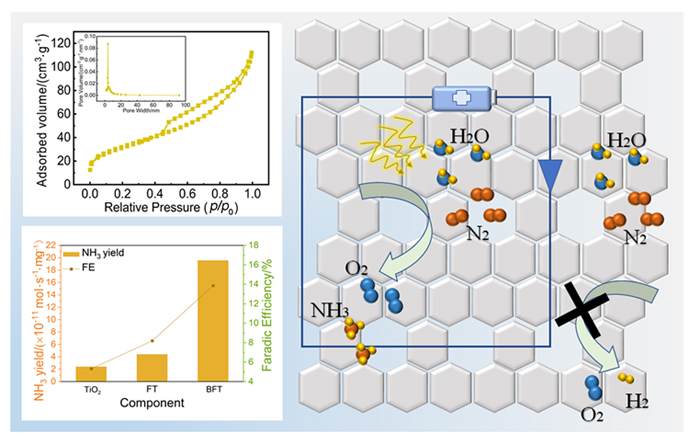| [1] |
Snyder, C. S.; Davidson, E. A.; Smith, P.; Venterea, R. T. Curr. Opin. Environ. Sustain. 2014, 9-10, 46.
doi: 10.1016/j.cosust.2014.07.005
|
| [2] |
Kroeze, C.; de Vries, W.; Seitzinger, S. P. Curr. Opin. Environ. Sustain. 2014, 9-10, 105.
doi: 10.1016/j.cosust.2014.09.009
|
| [3] |
Jonassen, K. R.; Hagen, L. H.; Vick, S. H. W.; Arntzen, M. Ø.; Eijsink, V. G. H.; Frostegård, Å.; Lycus, P.; Molstad, L.; Pope, P. B.; Bakken, L. R. ISME J. 2021, 16, 580.
doi: 10.1038/s41396-021-01101-x
|
| [4] |
Qing, G.; Ghazfar, R.; Jackowski, S.; Habibzadeh, F.; Maleka Ashtiani, M.; Chen, C.; Smith, M.; Hamann, T. Chem. Rev. 2020, 120, 5437.
doi: 10.1021/acs.chemrev.9b00659
|
| [5] |
Zhao, S.; Lu, X.; Wang, L.; Gale, J.; Amal, R. Adv. Mater. 2019, 31, 1805367.
doi: 10.1002/adma.201805367
|
| [6] |
Erisman, J. W.; Sutton, M. A.; Galloway, J.; Klimont, Z.; Winiwarter, W. Nat. Geosci. 2008, 1, 636.
doi: 10.1038/ngeo325
|
| [7] |
Suryanto, B. H. R.; Du, H.; Wang, D.; Chen, J.; Simonov, A. N.; Macfarlane, D. R. Nat. Catal. 2019, 2, 290.
doi: 10.1038/s41929-019-0252-4
|
| [8] |
Liu, J.; Wei, Z.; Dou, Y.; Feng, Y.; Ma, J. Rare Met. 2020, 39, 874.
doi: 10.1007/s12598-020-01451-z
|
| [9] |
Zhou, P.; Chao, Y.; Lv, F.; Lai, J.; Wang, K.; Guo, S. Sci. Bull. 2020, 65, 720.
doi: 10.1016/j.scib.2019.12.025
|
| [10] |
Zhao, Y.; Zhao, Y.; Shi, R.; Wang, B.; Waterhouse, G. I. N.; Wu, L. Z.; Tung, C. H.; Zhang, T. Adv. Mater. 2019, 31, 1806482.
doi: 10.1002/adma.201806482
|
| [11] |
Zhang, L.; Ji, X.; Ren, X.; Ma, Y.; Shi, X.; Tian, Z.; Asiri, A. M.; Chen, L.; Tang, B.; Sun, X. Adv. Mater. 2018, 30, 1800191.
doi: 10.1002/adma.201800191
|
| [12] |
Yu, J.; Yang, Y.; Wei, M. Acta Chim Sinica. 2019, 77, 1129. (in Chinese)
doi: 10.6023/A19070260
|
|
(余俊, 杨宇森, 卫敏, 化学学报, 2019, 77, 1129.)
doi: 10.6023/A19070260
|
| [13] |
Han, Q.; Wu, C.; Jiao, H.; Xu, R.; Wang, Y.; Xie, J.; Guo, Q.; Tang, J. Adv. Mater. 2021, 33, 2008180.
doi: 10.1002/adma.202008180
|
| [14] |
Huang, H.; Shi, R.; Zhang, X.; Zhao, J.; Su, C.; Zhang, T. Angew. Chem. Int. Ed. 2021, 60, 22963.
doi: 10.1002/anie.202110336
|
| [15] |
Liu, D.; Wang, J.; Bian, S.; Liu, Q.; Gao, Y.; Wang, X.; Chu, P. K.; Yu, X. Adv. Funct. Mater. 2020, 30, 2002731.
doi: 10.1002/adfm.202002731
|
| [16] |
Xiong, K.; Chen, J.; Yang, N.; Jiang, S.; Li, L.; Wei, Z. Acta Chim. Sinica 2021, 79, 1138. (in Chinese)
doi: 10.6023/A21040136
|
|
(熊昆, 陈伽瑶, 杨娜, 蒋尚坤, 李莉, 魏子栋, 化学学报, 2021, 79, 1138.)
doi: 10.6023/A21040136
|
| [17] |
Li, R.; Weng, Y.; Zhou, X.; Wang, X.; Mi, Y.; Chong, R.; Chong, R.; Han, H.; Li, C. Energy Environ. Sci. 2015, 8, 2377.
doi: 10.1039/C5EE01398D
|
| [18] |
Yu, W.; Zhao, L.; Chen, F.; Zhang, H.; Guo, L. J. Phys. Chem. Lett. 2019, 10, 3024.
doi: 10.1021/acs.jpclett.9b00863
|
| [19] |
Xu, F.; Meng, K.; Cheng, B.; Wang, S.; Xu, J.; Yu, J. Nat. Commun. 2020, 11, 4613.
doi: 10.1038/s41467-020-18350-7
|
| [20] |
Chen, X.; Shen, S.; Guo, L.; Mao, S. S. Chem. Rev. 2010, 110, 6503.
doi: 10.1021/cr1001645
|
| [21] |
Yu, L.; Liu, J.; Xu, X.; Zhang, L.; Hu, R.; Liu, J.; Ouyang, L.; Yang, L.; Zhu, M. ACS Nano 2017, 11, 5120.
doi: 10.1021/acsnano.7b02136
|
| [22] |
Pool, J. A.; Lobkovsky, E.; Chirik, P. J. Nature 2004, 427, 527.
doi: 10.1038/nature02274
|
| [23] |
Xiong, H.; Wu, L.; Liu, Y.; Gao, T.; Li, K.; Long, Y.; Zhang, R.; Zhang, L.; Qiao, Z.; Huo, Q.; Ge, X.; Song, S.; Zhang, H. Adv. Energy Mater. 2021, 9, 1901634.
doi: 10.1002/aenm.201901634
|
| [24] |
Zeng, M.; Zeng, X.; Peng, X.; Zhu, Z.; Liao, J.; Liu, K.; Wang, G.; Lin, S. Appl. Surf. Sci. 2016, 388, 352.
doi: 10.1016/j.apsusc.2015.12.169
|
| [25] |
Mi, P. P.; Guo, M. G.; Dai, Y.; Zhang, X. Mod. Chem. Ind. 2021, 41, 138. (in Chinese)
|
|
(米盼盼, 郭明钢, 代岩, 张旭, 现代化工, 2021, 41, 138.)
|
| [26] |
Cui, Z.; Song, H.; Ge, S.; He, W.; Liu, Y. Appl. Surf. Sci. 2019, 467-468, 505.
doi: 10.1016/j.apsusc.2018.10.181
|
| [27] |
Zhang, W.; Dong, X.; Liang, Y.; Liu, R.; Sun, Y.; Dong, F. Rare Met. 2019, 38, 437.
doi: 10.1007/s12598-019-01230-5
|
| [28] |
Xu, L.; Xie, Y.; Li, L.; Hu, Z.; Wang, Y.; Yu, J. C. Mater. Today Phys. 2021, 21, 100551.
|
| [29] |
Zhou, G.; Wang, F.; Shi, R. J. Catal. 2021, 398, 148.
doi: 10.1016/j.jcat.2021.04.017
|
| [30] |
Yamashita, T.; Hayes, P. Appl. Surf. Sci. 2008, 254, 2441.
doi: 10.1016/j.apsusc.2007.09.063
|
| [31] |
Zhao, Y.; Shi, R.; Bian, X.; Zhou, C.; Zhao, Y.; Zhang, S.; Wu, F.; Waterhouse, G. I. N.; Wu, L.; Tung, C.; Zhang, T. Adv. Sci. 2019, 6, 1802109.
doi: 10.1002/advs.201802109
|
| [32] |
Liu, Q. X.; Ai, L. H.; Jiang, J. J. Mater. Chem. A 2018, 6, 4102.
doi: 10.1039/C7TA09350K
|
| [33] |
Zhan, S.; Zhang, F. Acta Chim. Sinica 2021, 79, 146. (in Chinese)
doi: 10.6023/A20090412
|
|
(詹溯, 章福祥, 化学学报, 2021, 79, 146.)
doi: 10.6023/A20090412
|
| [34] |
Kang, S.; Zhang, H.; Wang, G.; Zhang, Y.; Zhao, H.; Zhou, H.; Cai, W. Inorg. Chem. Front. 2019, 6, 1432.
doi: 10.1039/C9QI00176J
|
 ), 张信义b,*(
), 张信义b,*( )
)
 ), Xinyi Zhangb(
), Xinyi Zhangb( )
)
